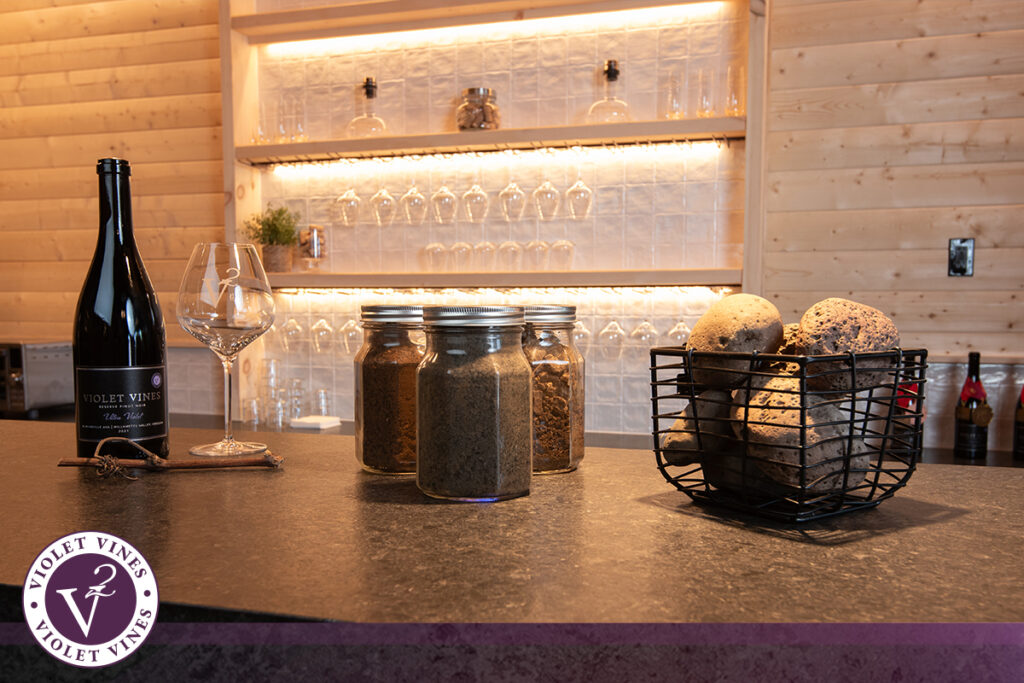Violet Vines’ Estate Soils
August 12, 2023
Ever read the book, Wine Wars? They use a term to classify those that truly value and promote terroir as “terroirists” (not terrorists). Well, I happen to be in the terroirist camp!
In my opinion, “terroir” is very real and can be a game-changer when the right varietal is planted in the right terroir.
To me, terroir is below, at and above the ground – beneath the soil, the soil, elevation, slope, aspect, temperature, wind and precipitation.
In this blog, I’d like to cover the soil in our two estate vineyards.
McMinnville AVA Estate Vineyard Soils
Violet Vines has 88 acres in the McMinnville AVA, which is the farthest western AVA in Oregon. Our vineyard has 26 acres planted, and rests in the foothills of the coast mountains.
If you were to visit these two websites (http://www.yamhillvalleywines.com/valley-avas and https://mcminnvilleava.org/terroir-of-mcminnville-ava/), you’d read a lot about the soils of the McMinnville AVA, including the following excerpt:
The soils in the McMinnville AVA are the oldest and most complex of any Oregon AVA, primarily consisting of uplifted marine sedimentary loam and silt with alluvial overlays. Beneath is a base of uplifting basalt. Clay and silt loam averages 20 to 40 inches in depth — the range in which the AVA’s terroir is best achieved — before reaching harder rock and compressed sediments shot with basalt pebbles and stone.
In general, our McMinnville AVA vineyard (17371 Gopher Valley Road, Sheridan, OR) has soils consistent with this description, but the property is unique in that it has a strong concentration of Jory soil as well.
When we were looking at the property before purchasing it in 2019, we did an in-depth (no pun intended) soil test, pulling deep samples in 18 different locations. Here’s a summary of the results:
In summary, 49.2% of the soil property is composed of Jory silty clay loam (series 2796C, 2797D & 2797E). There is a good layer of silty clay (28 inches) that’s well drained and offers good water storage (about 9.7 inches). Another 39.1% of the property is Gellatly-Dixonville complex (series 2794C, 2795D and 2795F) mostly composed of clay loam. It is well drained due to the presence of fractured rocks. Overall, these soils are structurally well suited for the establishment of grapes due to their slope aspect and elevation which is beneficial for drainage and to their sun exposure that spans from west to east.
Overall, we’re thrilled with the soil impact to-date and are excited to see the fruit from our 2020 planting of Chardonnay and Pinot noir.
Milton-Freewater AVA (Rocks District) Estate Vineyard Soils
In early 2022, we purchased a five-acre cherry orchard in Milton-Freewater AVA, specifically the Rocks District, and planted Syrah, Mourvèdre, and Grenache in 2023. For those unfamiliar with this incredibly unique growing region, here’s an excerpt from the district’s website, https://rocksdistrict.com/terroir.
The boundaries of the Rocks District of Milton-Freewater are based on the geographical distribution of soils of the Freewater series, which are derived from the cobblestone-rich gravels deposited by the Walla Walla River. The cobblestones consist entirely of basalt, a dark-colored volcanic rock (that was) derived by erosion of the Blue Mountains.
The Freewater series soils that mantle the alluvial fan of the Walla Walla River have unique attributes that strongly influence the cultivation of wine grapes and impart distinctive sensory characteristics to the wines produced from those grapes. Due to their coarse texture, the gravelly soils are excessively well drained, which encourages the vines to root deeply in pursuit of water. The coarse texture also discourages erosion, so the area between the vine rows can be free of cover crops.
The rocky bare soil between the rows absorbs solar energy and transmits it efficiently to the root zone of the vines promoting earlier onset of the phenological stages of the vine growth such as bud break, flowering, veraison, and ripening. The surface stones radiate heat that warms the grape clusters and influences the production of phenolic compounds during ripening.
When we visited the first time, much of the district looked like a landscaped rock garden with a thin layer of soil sprinkled on top. So unique!
Although this image of a rock garden vineyard may sound intriguing, you really don’t appreciate the soil (and rock) impact until you taste the wines. We purchased Rocks Syrah fruit in 2022 and look forward to releasing it in late Spring 2024. In 2023, we purchased Rocks District Chardonnay, Syrah, Grenache, Mourvèdre, and Albariño fruit, which we can’t wait to work with this Fall! Fingers-crossed, we’ll have estate Rocks Syrah ready to harvest in September 2024.

